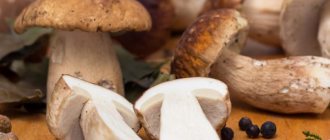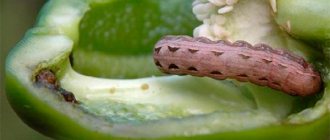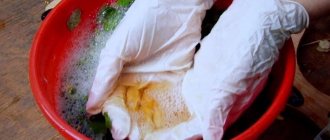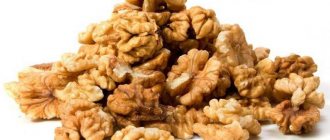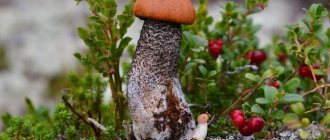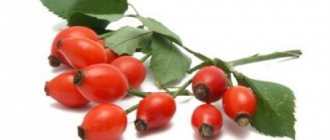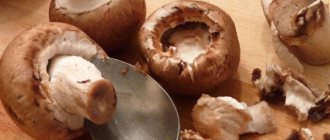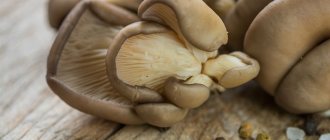General techniques or how to properly peel mushrooms
- They should not lie for a long time after they are collected. As a last resort, if it is not possible to process on the same day, place them in a cool place until the morning - in the refrigerator or cellar. There, putrefactive processes will be inhibited, and the forest harvest may be saved.
- Before cleaning, mushrooms must be inspected and sorted by size, degree of contamination, quality and your plans for them (pickling, pickling, drying, for food).
- It is not recommended to wash mushrooms immediately. To start, use the dry method. And not all mushrooms need washing.
- Arm yourself with a convenient knife to scrape the legs, and a soft sponge or brush with which you will remove sand and soil.
- To prevent mushrooms from turning black and harboring undetected worms, soak them briefly in salted water after dry cleaning.
How to assemble correctly
How to collect boletus mushrooms correctly
When collecting boletus mushrooms, you need to follow simple rules:
- The fruiting bodies should be carefully cut off at the base with a knife, or carefully unscrewed from the mycelium. This way you preserve the mycelium and it will delight you with its gifts more than once.
- The best time of the day to pick mushrooms is morning.
- You should not collect old or overgrown mushrooms - they do not have any special taste, and have accumulated too many harmful substances from the environment. The most optimal age for collecting boletus is 6 days.
- You should not pick mushrooms during the rain - the fruiting bodies will be too saturated with moisture, which will speed up the process of rotting after cutting.
Boletus mushrooms do not deteriorate so quickly after cutting, but you cannot delay processing them either - the deadline for this is 12 hours after cutting.
Is it necessary to wash?
When washed, mushrooms absorb a lot of moisture. Therefore, dry cleaning is recommended where possible. Mushrooms to be dried should absolutely not be washed; we wipe them with a damp cloth.
It is also better to do without washing before frying. If necessary, you can only quickly rinse them with water.
After dry cleaning, soak the remaining mushrooms briefly in cold salted water so that the remaining worms come out. Then wash thoroughly and use as intended - for:
- cooking;
- pickling;
- marinating.
Cleanliness of mushroom bodies: how to wash and peel boletus and aspen mushrooms
Summer has not yet arrived, but mushroom pickers are already preparing baskets. And it’s not surprising, because quiet hunting can be done from May until late autumn. And if picking mushrooms at the beginning of May is for experts, then by the middle of the month you can find the well-known and beloved boletus mushrooms, and then, lo and behold, the boletus boletuses have ripened. These sponge mushrooms, along with porcini mushrooms, are considered elite. They are fried, made into soup, sauces are prepared, stewed, dried, pickled - mushrooms are suitable for any method of cooking. But before that, the mushrooms need to be cleaned.
Pre-cleaning of mushrooms in the forest
The first stage of cleaning takes place in the forest. From each mushroom found, we remove the main debris: twigs, leaves, pine needles, moss. We clean the rhizome with a knife from soil and sand or simply cut it off to check for the presence of worms. Take with you on a “quiet hunt” a brush that can be used to clean the mushroom from sand and soil. We don’t accept “strangers.” It's like a drop of ointment in a barrel of ointment - one inedible mushroom in a basket can lead to poisoning. Let’s not be lazy: it’s better to immediately process each cut mushroom than to pore over a whole bunch later. This way you will save time and bring less garbage home.
We are not greedy: we leave wormy, “ancient” and moldy specimens to live out their lives in the forest.
What to do with mushrooms: processing
There are some tricks that allow you not only to prepare a mushroom dish correctly and tasty, but also to protect yourself from unpleasant consequences. Such rules include the following:
- If the mushroom is whole, undamaged, but still appears to be old, you should always completely remove the spore-bearing core, located at the very bottom of the stem of the fruit.
- Old ripened boletus mushrooms are healthy and tasty, but if the cap of the mushroom is covered with mucus and is unnaturally soft, then this indicates a long period of ripening. In this case, it is better to completely remove such areas.
- You can save yourself and your loved ones from intestinal disorders and possible poisoning by completely removing all ripe spores from mushrooms. As a rule, their increased content is observed in plates and sponges. The thing is that this part is practically not digested by the human body, and therefore can be harmful to health.
- There is an opinion among experienced mushroom pickers that peeled, processed and washed boletus mushrooms should be immersed in ice water. It is enough to wait 30-40 minutes and continue cooking.
- Regardless of the recipe, many experts still advise soaking the mushrooms in cold water. It is often recommended to soak the fruits even before cleaning, in order to facilitate the removal of leaves, sand, soil and remnants of forest herbs.
- Before implementing any canning recipe, you can immerse boletus mushrooms in cold water, changing it 3-4 times.
- When soaking, you can add a small amount of ordinary table salt, thereby providing basic measures for disinfecting the prepared products.
The secret that our grandmothers used was to add a regular onion while cooking the mushrooms. Excessive darkening or blackening of the bulb indicates unsafe use, content of harmful substances and, possibly, poisons. What to do with mushrooms that have such a “symptom”? It's better to throw it away so as not to endanger your family.
There are many options for preparing boletus mushrooms and various recipes. Among them, everyone will find something to their liking for themselves and their loved ones.
Step-by-step instruction
Algorithm for cleaning boletus mushrooms:
- At the collection site , clean the mushroom from forest debris by scraping it off with a knife or a stiff brush. This is done especially carefully if the mushroom is planned to be dried.
- At home , remove external dirt with a brush and a damp cloth.
- Cut out darkened, softened areas - passages of insects and worms.
- Remove the spongy layer under the cap if the mushroom is old.
- Scrape off the gray layer on the stem with a knife. Wipe the hat with a damp cloth.
- Rinse the mushrooms if they are not dried. For “roasting”, mushrooms are rinsed with water. Before cooking, wash for a maximum of 10 and allow to dry.
How to preserve a product:
- The product must be placed in jars hot, immediately after preparation.
- The formation of voids inside the jar should not be allowed.
- Place the lids on the jars, but do not screw them on yet.
- Disinfect the jars in the oven for 15 minutes at a temperature of 120 degrees, then screw the lids tightly. Some people pour a spoonful of sunflower oil into each jar before twisting, believing that this extends the shelf life.
- While the jars are cooling, invert them onto their lids.
- Store cooled jars in a cellar or other dark and cool place. Storage temperature should be maintained in the range from 0 to + 10 degrees.
The shelf life of canned boletus mushrooms should not exceed 12 months.
Boletus mushrooms are one of the most delicious mushrooms in Russian forests, classified as absolutely edible. However, in handling them, care must be taken, carefully and correctly cleaning them after collecting them in the forest, and properly preparing them for further culinary processing.
Secrets of proper cleaning of boletus mushrooms
Boletus mushrooms are often attacked by worms. In order not to carry a stupid load home from the forest, which will still end up in the trash, having infected previously healthy mushrooms, immediately after finding it, cut off the tip of the mushroom’s stem. In worm-bearing specimens, characteristic dark dots will be visible on the cut - worm passages. For large “individuals”, the cap is separated for the same purpose and cut in half. Worms can live in the lower part of the cap, even if the rest of the mushroom is not affected. In this case, the entire spongy layer is removed.
Boletus mushrooms should be processed after harvest according to the general rules, but there is one peculiarity. The main point is cleaning rough legs. You need to completely remove the top layer of gray ripples from them.
The leg is carefully cleaned with a knife, scraping off the top, gray layer of skin, although some mushroom pickers believe that this is not necessary. Old monkeys' legs become hard and fibrous. It is recommended not to use such parts in cooking.
The caps are wiped with a damp sponge, cut in half and checked for worms. It is better to remove the spongy part: it is difficult to digest and becomes disgustingly slippery when cooked.
How long to cook boletus mushrooms until tender
In order to bring the boletus mushrooms to full readiness, you should cook them for 40 minutes. This period can be divided into two equal intervals: after the first, drain the broth and replace it with new water.
Additional cooking somewhat reduces the taste of boletus mushrooms. However, the toxins contained in them can be removed quite successfully by boiling. The complete readiness of the product is judged by the moment the mushrooms drop to the bottom of the pan.
Many housewives advise not only boiling boletus mushrooms in “two waters,” but also adding an onion to the broth. It can be used to judge the edibility of the fruiting bodies. If the color changes to blue, then there is a poisonous specimen in the pan.
Answers to questions from mushroom pickers
Question: After cleaning mushrooms, my fingers turned black. Can't be washed with soap. How to solve this problem?
Answer: The problem is related to the content of the coloring pigment in mushroom juice. This applies equally to all types of mushrooms, but more so - butter. You won't be able to remove plaque with soap. On the contrary, interacting with soap, the pigment will appear even stronger, penetrate into the pores of the skin and can remain until the skin is completely renewed. Alcohol, cologne or vodka, solvents and scrubs are not suitable for cleaning hands.
There are budgetary, affordable and effective means. One of them is a bath with citric acid : we dilute the contents of a bag of acid in water, put our hands down for a few minutes. You can also use lemon. Then we wash our hands under running water, wipe them dry and lubricate them with nourishing cream.
To avoid the hassle of cleaning your hands, it is better to handle mushrooms using household gloves.
Question: Are boletus mushrooms dried and, if so, do they need to be washed before drying?
Answer: Boletus mushrooms are salted, pickled and, of course, dried. Dried mushrooms are in no way inferior in taste to porcini mushrooms. The only drawback is that when drying, as with other manipulations, they darken. But their dishes turn out tasty and aromatic.
The quality of dried mushrooms depends on the correct sequential actions.
It is strictly forbidden to wash boletus mushrooms, like other mushrooms that need to be dried. These are wiped with a damp cloth or brush. If the dirt does not come off, cut off the contaminated area with a knife.
Question: The mushroom is a little wormy. It's a shame to throw it away. Is it possible to make worms come out of it?
Question: If the mushrooms are not severely damaged by worms, then soaking them in slightly salted water (too salty water can kill and the worms will remain inside) for an hour will help get rid of the parasites. Then rinse the mushrooms thoroughly and place in a colander. There is no point in “saving” severely damaged ones, since there is nothing useful left in them. It’s better not to take them home at all, but to leave them in the forest.
The method is not suitable for mushrooms that are planned to be dried, but this is not a problem. During the drying process, deprived of their usual comfortable living conditions, the worms themselves leave the mushrooms in such a panic.
Why do forest mushrooms quickly become wormy in the heat?
Question: Indeed, in the summer heat, mushrooms quickly become infected with worms. To understand why this happens, let's figure out what fungal worms are. These are nothing more than fly or fungus gnat larvae that develop in the body of the fungus, feeding on it. They were born from eggs laid on the mushroom by their “parents”. Hot, dry weather creates favorable conditions for the reproduction of these insects, and the tiny eggs that they lay after mating on the mushroom are not washed away by rain. After some time, these eggs transform into larvae, which, at elevated air temperatures, quickly turn into a fly or mosquito.
In the forest, the ability of the soil and, accordingly, the fungus to retain moisture is higher than in open areas. This allows mushrooms to grow further without drying out, and insect populations to increase their numbers faster.
Beneficial properties of boletus mushrooms or why they are collected
These mushrooms are a real treasure for those who care about their health, since the content of useful substances is many times higher than the norm. So in 100g of this product, which, unfortunately, is a seasonal pleasure, you have:
- proteins – 36%;
- fat -5%;
- sugar –15%;
- fiber – 23%.
There are also valuable B vitamins, organic acids, and a whole range of microelements necessary for good health - potassium, sodium, phosphorus, manganese and even iron. Mushrooms should be cooked immediately to preserve maximum vitamins. These mushrooms, like others used for food, have been subject to close attention of scientists, therefore it has been officially proven that boletus protein is a complete product that can replace protein of animal origin, in addition, it contains all the amino acids important for humans. You can prepare dishes using only the caps or mixing them with the legs - the taste and value will be equally high. It is necessary to cook mushrooms before pickling, just as before eating them fried, this way you can avoid health problems.
It is very valuable from a nutritional point of view that boletus proteins are easily broken down and therefore are perfectly absorbed. Their high fiber content promotes the removal of toxins, which accumulate in large quantities in the intestines, complicating the functioning of all organs related to the gastrointestinal tract. In the practice of using mushrooms of this variety, there are cases of using boletus for the effective and rapid treatment of kidney disease.
Important points: boiling or other rapid processing, such as marinade or caviar production, helps preserve nutritional value. In order to enjoy mushrooms, naturally, you should know how to cook them correctly. Boletus mushrooms are one of those mushrooms that lend themselves well to frying, but they are also easy and quick to cook.
Thus, all parts of the mushrooms, especially the stems, must be thoroughly cleaned and boiled for later cooking. Before any processing other than drying, they should be soaked in water for 60 minutes to several hours, depending on the condition of the pulp and the age of the boletus mushrooms found. The more thoroughly the processing is carried out, the tastier the dish prepared from them will be, so it is important to devote maximum time and effort to the initial stage of work, so that later you can enjoy the tenderness and nutritional value of mushrooms.
Features of boletus and boletus
Among the wide variety of types of mushrooms, boletuses and boletuses, which grow mainly in deciduous forests, are held in particular esteem by mushroom pickers.
Boletus - tasty and healthy mushrooms
Their beautiful and neat caps, sticking out in the leaves and grass, instantly attract the attention of lovers of “quiet hunting”, eager to fill their baskets to the top with this valuable and useful product.
You can prepare many delicious dishes from boletus mushrooms.
Acting as a real storehouse of useful elements, boletus and boletus contain:
As well as a number of vitamins belonging to group B and microelements, including:
- sodium;
- iron;
- manganese;
- potassium;
- phosphorus.
Being complete, the proteins of these mushrooms are easily broken down and absorbed in a short period of time. This is due to their special nutritional value. In addition, by consuming boletus and boletus, you can effectively remove toxins from the body, as well as cure some kidney diseases.
Mushroom cleaning procedure
How to properly clean boletus mushrooms, should they be washed and is it necessary to do this at all? These questions are of interest to most housewives who like to add mushrooms to food and prepare them for the winter.
After picking or purchasing mushrooms, it is important to process them as quickly as possible. Such a product cannot be stored for a long time, so it is better to fry or dry them. This must be done to preserve all the vitamins and beneficial properties.
To properly clean mushrooms after picking, you should know where they grew.
Mushrooms from the forest should be cleared of debris, grass, and other elements. The specificity is that all dirt is removed quickly and easily. Particular attention should be paid to cleaning and washing the legs - dirt leaves the caps almost immediately. To make sure that there are no worms in the boletus, you need to make an incision in the flesh.
Cleaning the boletus mushrooms that were collected in the clearing is a little different. Due to the open area, there is mostly no dirt on the mushrooms, but despite this, there is dust and leaves. In this case, you need to scrape well with a knife to remove any stuck debris. All damaged areas, if present, are also removed.
Initially, before you start cleaning, you need to select mushrooms according to the following criteria:
How to clean boletus? The stages of cleansing are as follows:
- you will need a knife, an unnecessary toothbrush;
- needles, leaves, small forest debris are removed from the cap and stem with a brush;
- the lower base needs to be cut off, then a little higher, go around with a knife in a circle, removing dirt;
- clean the entire leg, removing the skin;
- cut the cap and stem in half, checking for the presence of worms;
- cut the peeled product into pieces of the required size.
If the boletus is young and strong, it is put aside, as it will quickly clear itself. But large, old mushrooms will need to be cleaned more carefully.
Do not forget about the possible presence of worms; they are often found in the leg. The wormy mushroom needs to be soaked in salted cold water (the solution will require a liter of water and 2 tablespoons of salt) or throw it away.
If the product is not to be fried, and the mushrooms will be dried, then you need to choose the strongest ones from the collected boletus mushrooms, without the worm. You cannot remove dirt by soaking, because then the mushrooms will not dry well and, most likely, will become unfit for consumption. Boletus mushrooms that will be dried are recommended to be cleaned of dirt using a dry cloth or scraped off with a knife.
Very dirty boletus mushrooms and those mushrooms that are to be boiled or fried must be soaked in water for an hour. Then rinse well and proceed to subsequent processing.
It is important to pay attention to the fact that the product quickly absorbs any debris. Therefore, you should cast aside all doubts about whether it is necessary to clean the mushrooms or whether you can just wash them.
If boletus is not washed or poorly processed, the taste characteristics and quality of the prepared dish can be ruined. Problems with the stomach and intestines are also possible.
You can cook or fry boletus mushrooms only when they are completely peeled.
To preserve the product in the freezer, you need to cook it in salted water for 20 minutes twice.
How to distinguish boletus from false boletus
The forest is a big and wonderful world, fraught with a lot of beauty, but it also hides a lot of dangers. It is known that poisoning with poisonous mushrooms very often ends in death, therefore, it is necessary to carefully examine each collected specimen, and put in your basket only those that do not cause any suspicion.
The first boletus flowers appear in mid-summer and grow until late autumn. The very name of the mushroom suggests that it prefers to live under birch trees, but can also be found under aspen trees and in open meadows. In appearance, the boletus has a discreet grayish color; the cap can be from white to brown. The stem of the mushroom is usually white and covered with longitudinal grayish scales - somewhat reminiscent of birch bark in color.
In addition to true boletus, false boletus is also quite common; sometimes they are also called gall mushroom. This poisonous specimen successfully disguises itself as a real one and can easily deceive an inexperienced mushroom picker. Just one such mushroom is enough to give any prepared dish an unpleasant bitter taste.
The main distinguishing feature of the false boletus is that it is not eaten by worms, so it is always smooth and beautiful. If you come across an absolutely pure mushroom, take a closer look at it, perhaps it only looks like it’s edible.
Carefully inspect the stem - the false boletus does not have a speckled net, similar to the colors of the birch. The veins of the false mushroom are more like a blood artery. Now we carefully examine the cap - if its bottom is pink, then the mushroom can be safely thrown away. True boletus does not have pink tints. If the cap is broken off, the break will also be pink, but on a real mushroom the break should be white.
In addition, the cap of the false mushroom always has a greenish impurity, and it is somewhat velvety to the touch. The true boletus has a smooth cap of a brown or grayish tint.
If the picked mushroom is still in doubt, you can try to lick it - the gall mushroom will taste very bitter.
Without delaying
Mushroom pickers know that preliminary cleaning of mushrooms must be done in the forest. Even if you are a supporter of picking mushrooms by twisting them out of the mycelium, take a knife with you into the forest. It is useful for pre-processing the crop.
Preliminary cleaning and sorting of mushrooms must be carried out in the forest
- Before putting the mushroom in the basket, remove any remaining soil, adhering twigs, leaves and needles from it.
- Remove the worm pulp, otherwise the worms will damage neighboring mushrooms.
- Get rid of poisonous and simply questionable mushrooms. It’s better to throw away ten dubious ones than to have one poisonous one end up in your basket.
- For mature mushrooms with a loose sponge, it is better to remove it on the spot; anyway, you will have to throw it away later. And once in the basket, the sponge tubes can tightly stick to the caps of neighboring mushrooms and will add problems to you during subsequent cleaning.
- It is better to throw away old and rotten mushrooms on the spot. Their taste and aroma leave much to be desired, and a shapeless, slippery mass instead of a mushroom can survive until processing.
Processing in the forest can be limited to this; the rest of the work is done at home.
When to wash and soak mushrooms
It is best to avoid washing mushrooms if possible. Spongy (and some lamellar) varieties quickly absorb moisture, losing flavor. The best option is dry cleaning and wiping with a damp cloth.
All so-called milkweeds need soaking. Cuts of such mushrooms exude white (only saffron milk caps have orange) juice and are used for pickling. These include milk mushrooms, valui, and tremors. Soaking helps repel unpleasant bitterness.
They are filled with cold water for at least a day, maximum for three, changing it at least once a day (preferably 3-4). For little-known bitters and pigs, the period increases to 4–7 days. If you add salt to the water (about a tablespoon per liter), you will get rid of the worms in the pulp.
After soaking the mushrooms, do not forget to regularly change the water in the container at least once a day
It is also recommended to soak Polish mushrooms. Any damaged areas quickly turn blue. When cooked, the liquid turns out almost black. Soaking for 3-4 hours allows the mushrooms to return to a more aesthetically pleasing light color.
The slightest damage to the Polish mushroom leads to its flesh turning blue
Video: the process of soaking mushrooms
Time to collect and time to clean
Unprocessed mushrooms are stored for only 6-8 hours from the moment of collection, so after a forest walk you will have to postpone rest. The cleaning process is much less exciting than collecting, but it is not worth removing it from the mushroom processing process in order to preserve what you have collected and avoid getting food poisoning.
Mushrooms brought from the forest need to be processed as quickly as possible.
